Meaning & Description
The 💀 Skull Emoji, represented by the Unicode character U+1F480, is a commonly used emoji in digital communication to symbolize death, mortality, and various related concepts, such as danger, creepiness, or spookiness. The 💀 Skull Emoji appeared in Unicode Version 6.0 in 2010 with the Unicode name “Skull” and was officially included in Emoji Version 1.0 in 2015. Here’s some information about this emoji:
Appearance: The Skull emoji features a white or off-white human skull, typically depicted from a front-facing perspective. It often includes two hollow eye sockets, a nasal cavity, and a lower jawbone, but the specific design may vary slightly across different platforms.
Usage: The Skull emoji is used to convey a range of ideas and emotions, most notably associated with death or mortality. It’s often used to indicate that something is scary, dangerous, or ominous. In some cases, it’s used in a playful or humorous context, such as during Halloween or when referencing horror-related content.
Variations: The appearance of the Skull emoji can vary slightly in design, color, or style depending on the platform or device you’re using. However, the core elements of a front-facing human skull are consistently present.
Meaning: The primary meaning of the Skull emoji is to symbolize death, mortality, or the macabre. It’s also used to represent danger, spookiness, or things that are eerie or unsettling. In some cases, it can be used humorously or playfully, such as in the context of Halloween or when discussing horror-themed content.
Examples of Use:
- “I just watched a really scary movie last night. 💀”
- “Be careful in that area; it’s known for being dangerous at night. 💀”
- “Ready for some spooky fun this Halloween? 🎃💀👻”
Related Emojis: The Skull emoji is often used in conjunction with other emojis to create context or express a particular theme. For example, it might be combined with 🎃 Jack-O-Lantern to celebrate Halloween or with 👻 Ghost to create a more playful or whimsical spooky atmosphere.
In summary, the 💀 Skull Emoji (U+1F480) is a versatile emoji that can be used to represent death, mortality, danger, spookiness, or macabre themes in digital communication. It’s commonly used in various contexts to convey a sense of eeriness or to celebrate Halloween.
💀💀 Skull Emoji Information
| Emoji CLDR Short Name | skull |
| Shortcode | :skull: |
| Windows ALT Code | ALT 128128 |
| Windows ALT X Code | 1F480 ALT X |
| Other Keywords | death | face | fairy tale | monster | skull |
| Emoji Group | Smileys & Emotion |
| Emoji Subgroup | face-negative |
| Introduced in Unicode Version (and Release Year) | 6.0 (2010) |
| Introduced in Emoji Version (and Release Year) | 1.0 (2015) |
| Unicode Character Name | Skull |
| Unicode Code Point(s) | U+1F480 |
| Unicode Block | Miscellaneous Symbols and Pictographs |
| Unicode Block Subheading | Fairy tale symbols |
| Other Unicode Character Description Or Alias |
Emoji Appearance on Different Devices & Platforms
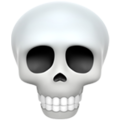
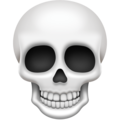
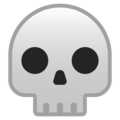
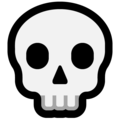
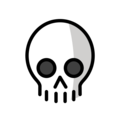
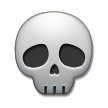
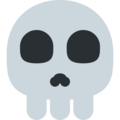
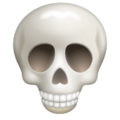
Emoji Codes for Developers
| Hexadecimal Code | 1F480 |
| Decimal Code | 128128 |
| HTML Entity HEX | 💀 |
| HTML Entity DEC | 💀 |
| URL Escape Code | %F0%9F%92%80 |
| Bytes (UTF-8) | \xF0\x9F\x92\x80 |
| Punycode | xn--fr8h |
| PHP, Ruby | \u{1F480} |
| Java, JavaScript, JSON | \u1F480 |
| C, C++, Python | \u1F480 |
| Perl | \x{1F480} |
| CSS | \01F480 |
💀 Skull Emoji Name in Other Languages
| Arabic Short Name | جمجمة |
| Arabic Keywords | جسم | جمجمة | حدوتة | وجه |
| Bengali Short Name | খুলি |
| Bengali Keywords | খুলি | দানব | মুখ | মৃত্যু | রূপকথা | শরীর |
| Bulgarian Short Name | череп |
| Bulgarian Keywords | лице | смърт | тяло | череп | чудовище |
| Catalan Short Name | crani |
| Catalan Keywords | calavera | cara | conte | crani | monstre | mort |
| Chinese Short Name | 头骨 |
| Chinese Keywords | 头骨 | 妖怪 | 死亡 | 神话故事 | 脸 |
| Croatian Short Name | lubanja |
| Croatian Keywords | bajka | čudovište | lice | lubanja | smrt |
| Czech Short Name | lebka |
| Czech Keywords | lebka | pohádka | příšera | smajlík | smrt | tělo | tvář | výraz |
| Danish Short Name | kranium |
| Danish Keywords | dødningehoved | kranie | kranium |
| Dutch Short Name | schedel |
| Dutch Keywords | dood | gezicht | monster | schedel | sprookje |
| Estonian Short Name | kolp |
| Estonian Keywords | kolm | kolp | kondid | luud | muinasjutt | nägu | pealuu | surm |
| Filipino Short Name | bungo |
| Filipino Keywords | alamat | bungo | fairy tale | halimaw | kamatayan | lason | mukha |
| Finnish Short Name | pääkallo |
| Finnish Keywords | hirviö | kuolema | naama | pääkallo | ruumis | satu |
| French Short Name | crâne |
| French Keywords | corps | crâne | fantastique | mort | visage |
| German Short Name | Totenkopf |
| German Keywords | Gesicht | Tod | tot | Totenkopf |
| Greek Short Name | κρανίο |
| Greek Keywords | θάνατος | κρανίο | παραμύθι | πρόσωπο | σώμα | τέρας |
| Hebrew Short Name | גולגולת |
| Hebrew Keywords | גולגולת | מוות | מפחיד | פרצוף | שלד |
| Hindi Short Name | खोपड़ी |
| Hindi Keywords | खोपड़ी | चेहरा | परी कथा | शरीर |
| Hungarian Short Name | koponya |
| Hungarian Keywords | csont | halál | koponya | szörny |
| Indonesian Short Name | tengkorak |
| Indonesian Keywords | dongeng | mati | mayat | monster | muka | tengkorak | wajah |
| Italian Short Name | teschio |
| Italian Keywords | favola | morte | mostro | teschio |
| Japanese Short Name | ドクロ |
| Japanese Keywords | スカル | ドクロ | 死 | 顔 | 骸骨 |
| Korean Short Name | 해골 |
| Korean Keywords | 해골 | 해골 바가지 |
| Latvian Short Name | galvaskauss |
| Latvian Keywords | galva | galvaskauss | nāve |
| Lithuanian Short Name | kaukolė |
| Lithuanian Keywords | kaukolė | mirtis | monstras | pasaka | veidas |
| Malay Short Name | tengkorak |
| Malay Keywords | badan | cerita dongeng | kematian | muka | raksasa | tengkorak |
| Marathi Short Name | कवटी |
| Marathi Keywords | कवटी | चेहरा | परीकथा | मृत्यू | राक्षस |
| Norwegian Short Name | hodeskalle |
| Norwegian Keywords | død | dødninghode | fjes | hodeskalle |
| Polish Short Name | czaszka |
| Polish Keywords | czaszka | duch | kościotrup | potwór | śmierć | szkielet | trupia czaszka |
| Portuguese Short Name | caveira |
| Portuguese Keywords | caveira | conto de fadas | corpo | morte |
| Romanian Short Name | craniu |
| Romanian Keywords | basm | craniu | față | moarte | monstru |
| Russian Short Name | череп |
| Russian Keywords | голова | опасность | смерть | страх | череп |
| Serbian Cyrillic Short Name | лобања |
| Serbian Cyrillic Keywords | бajкa | лице | лобања | смрт | тeлo | чудoвиштe |
| Serbian Latin Short Name | lobanja |
| Serbian Latin Keywords | bajka | čudovište | lice | lobanja | smrt | telo |
| Slovak Short Name | lebka |
| Slovak Keywords | lebka | rozprávka | smrť | tvár |
| Slovenian Short Name | mrtvaška glava |
| Slovenian Keywords | mrtvaška glava | obraz | pošast | pravljica | smrt | telo |
| Spanish Short Name | calavera |
| Spanish Keywords | calavera | cara | cuento | monstruo | muerte |
| Swedish Short Name | dödskalle |
| Swedish Keywords | dödskalle | döskalle |
| Tamil Short Name | மண்டை ஓடு |
| Tamil Keywords | உடல் | மண்டை ஓடு | முகம் | விசித்திரக் கதை |
| Telugu Short Name | పుర్రె |
| Telugu Keywords | పుర్రె |
| Thai Short Name | หัวกระโหลก |
| Thai Keywords | กะโหลก | หัวกระโหลก |
| Turkish Short Name | kafatası |
| Turkish Keywords | kafatası | masal | ölüm | yüz |
| Ukrainian Short Name | череп |
| Ukrainian Keywords | казка | монстр | обличчя | смерть | тіло | череп |
| Urdu Short Name | کھوپڑی |
| Urdu Keywords | افسانوی | جن | چہرہ | کھوپڑی | موت |
| Vietnamese Short Name | đầu lâu |
| Vietnamese Keywords | cái chết | đầu lâu | mặt | quái vật | truyện cổ tích |